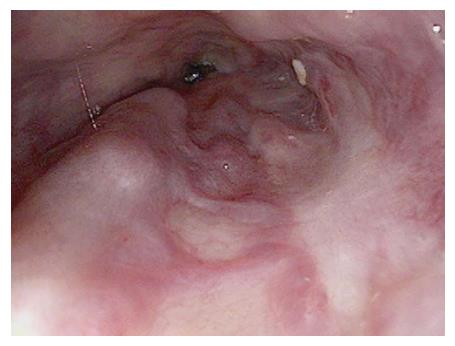Copyright
©The Author(s) 2016.
World J Hepatol. Jul 8, 2016; 8(19): 790-795
Published online Jul 8, 2016. doi: 10.4254/wjh.v8.i19.790
Published online Jul 8, 2016. doi: 10.4254/wjh.v8.i19.790
Figure 1 Grade III varices in distal esophagus on pre-procedure esophagogastroduodenoscopy.
Figure 2 Intra-procedure steep oblique fluoroscopy of upper abdomen during mesocaval shunt placement.
First, a needle is inserted percutaneously (black arrowhead) and directed through the portal vein remnant at a target snare placed in the inferior vena cava (white arrowhead) via internal jugular (IJ) access sheath (red arrowhead) (A). The wire is then threaded from its original percutaneous entry via the needle through the IJ sheath (red arrowhead) so that it extends from the IJ and is seen coiling in the splenic vein (black arrowhead) (B). The unexpanded stent graft (white arrowhead) is passed over the wire using Seldinger technique with fluoroscopic guidance (B). Coils are placed in varices (blue arrowhead) (B). Shuntogram with contrast 22 mo post-procedure shows functioning mesocaval shunt (white arrowhead) with tip in the splenic vein (black arrowhead) and absent varices (C). Previous coils in the varices are still visible (red arrowhead).
- Citation: Davis J, Chun AK, Borum ML. Could there be light at the end of the tunnel? Mesocaval shunting for refractory esophageal varices in patients with contraindications to transjugular intrahepatic portosystemic shunt. World J Hepatol 2016; 8(19): 790-795
- URL: https://www.wjgnet.com/1948-5182/full/v8/i19/790.htm
- DOI: https://dx.doi.org/10.4254/wjh.v8.i19.790














